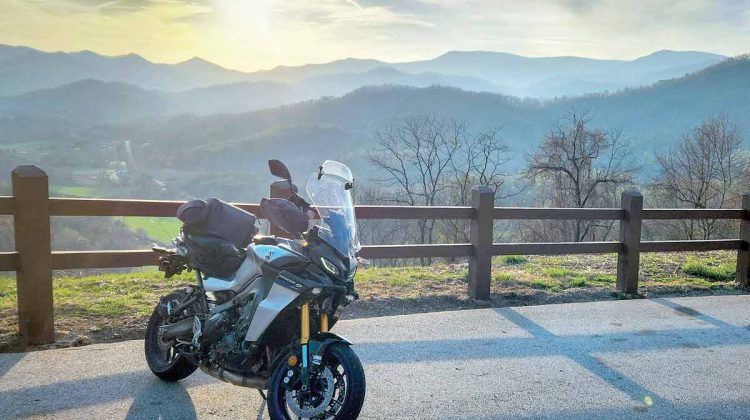
I eased my new Yamaha to a halt on the quiet bridge over the Tugaloo River, stopping on the state line between South Carolina and Georgia. I followed the Blue Ridge Mountains down through the Carolinas all morning to explore this corner of the Peach State. There wasn’t much room next to the railing of the river crossing, but the rare passing pick-up truck didn’t seem to mind the high-viz clad tourist snapping pictures in the middle of the road.
As the lazy waters beneath the bridge made their way toward the Atlantic, I admired my new Tracer 9 GT while repacking my camera gear — pausing to wave off well-meaning motorists wondering if I’m in distress. I was still missing some aspects of my beloved-and-well-traveled Suzuki V-Strom 1000, which I left behind at the dealership when I rode off on this new triple-cylinder, sport-touring bike six weeks ago. My minor quibbles about the Yamaha were quickly eclipsed by that new-bike euphoria every rider feels during the honeymoon phase of ownership.
My plan for the day was a big loop through the northeast corner of Georgia, visiting a few towns that I always seemed to bypass on previous rides through the region.
Following U.S. 123 west, I soon rolled through Toccoa, home to a beautiful namesake waterfall on a small college campus. You’ll find it behind the campus bookstore, where they ask for a modest admittance fee. It’s worth it to visit the peaceful, well-kept park next to the base of the falls.
Outside of town, a lone mountain peak rises. I realize it’s Currahee — the famed training ground for World War II paratroopers made famous in “Band of Brothers.” The military is long gone, but you can visit the site where the men who dropped behind enemy lines to liberate Europe earned their jump wings. Camp Toccoa at Currahee, open to visitors on most weekends, offers displays and artifacts celebrating the heroism of the 6,000 paratroopers who passed through this camp in the 1940s.
The road takes me toward the towering Currahee, and I feel a bit annoyed seeing this historic mountain now bristling with 21st century communication towers. I keep glancing at it as the road winds westward and it disappears behind me. I find solace in the empty backroads of Georgia, where the tall pines glide past me as the Yamaha sings its triple-cylinder harmony.
Always seeking to avoid four-lane highways, I switch off my GPS and turn to my trusty paper maps. Electronic navigation aids always seem to annoy and anger me, but holding a paper map brings me a feeling of discovery and excitement. As a kid, I would sprawl out on the living room floor and stare at my parents’ large Rand McNally Road Atlas for hours.
The wrinkled and folded paper map helps me find a network of backroads heading roughly southeast to the southernmost corner of my loop — Dawsonville. I memorize the next two road numbers where I need to turn. No annoying computer voice to remind me, just my own inner thoughts. It’s a weekday. Traffic is almost non-existent and the weather comfortable. I play with some of the gadgets on this new Tracer 9, suspension settings, ride modes, cruise control, quick shifter, heated grips. There’s more technology on it than I usually prefer, but even the Luddite in me appreciates them when it enhances my riding pleasure.
Soon I roll into Dawsonville. I make a loop of the downtown traffic circle, admire the water tower and cruise across town to my treat for the day — the Georgia Racing Hall of Fame. I find the museum set amid an impressive municipal complex and shopping center and eagerly make my way inside to see racing cars from the 1940s to present, including the town’s local father-son racing legends, “Awesome Bill from Dawsonville” Elliott and his son, Chase Elliott.
“We have Bill’s first-win car. Chase’s first-win car. They are in the exhibit together,” said Steve Cox, a volunteer with the Georgia Racing Hall of Fame. The museum opened in 2002 and chronicles the rich racing history of this county. “Originally Raymond Parks is from here. He’s one of the people who helped found NASCAR. He had four drivers running four cars from local people from here.”
A gleaming blue-and-white 1964 Ford Falcon immediately attracts my eye. It’s a replica of the car raced by Jody Ridley across the South. It reminded me of a high school friend who loved peeling out of the school parking lot in his red 289 Falcon coupe, so much so he once greased his rear wheels and smoked the tires in an epic 3 p.m. exit. I can’t remember any algebra from high school, but I’ll never forget who put down the longest black mark.
As was true in the Carolinas, stock car racing in these parts grew out of friendly competition between illegal whisky runners.
“Dawsonville was big in moonshine. I know there were a lot of people moonshining around here. Nobody will tell you they actually did it, but you know they did,” Cox said.
One moonshine route those early drivers ran still offers thrills for today’s two-wheeled travelers roaming the backroads north of Atlanta.
“Highway 19, that goes up through the mountains. That’s an awesome motorcycle ride. The next town over, Dahlonega, it’s a little bit bigger. It’s got a lot of nice restaurants and shops. It’s just 10 miles up the road.”
After enjoying all the museum exhibits, I climb back aboard the Yamaha and begin my northern half of the loop by following Cox’s suggestion to visit Dahlonega. A brief ride up the old Dawsonville Highway, I enter Dahlonega, where the road divides at the town square. In the middle sits one of Georgia’s oldest standing courthouse buildings, now home to the Dahlonega Gold Museum.
Many people are not aware that Georgia and North Carolina both had gold rushes in the early 1800s. North Georgia attracted thousands of prospectors to mine the region’s gold deposits. A branch of the U.S. mint opened in Dahlonega in 1838, coining more than $6 million in gold before the Civil War.
“Our collection is focused primary on three things, the 1829 gold rush, which was the first major gold rush in the United States, about 20 years before that little, tiny one in California that they’re so proud of. We also focus on the history of the Dahlonega Mint that was established here due to the gold production. We also have a full set of gold coins on display, very rare. Then the history of the building itself, which is the old Lumpkin County Courthouse built in 1836,” said Marcia Bennett, a ranger with Georgia State Parks and Historic Sites.
The museum is open seven-days a week, except for holidays, and a tour takes about 45 minutes to cover the two-story building. Nearby, a host of restaurants and souvenir shops make for a pleasant stroll around the square.
Besides gold, the region is also rich in scenic beauty. Just northwest of both Dawsonville and Dahlonega, Amicalola Falls State Park & Lodge contains a spectacular 729-foot waterfall as well as hiking, camping and other outdoor recreational opportunities.
“Amicalola Falls State Park & Lodge is home to the tallest waterfall in Georgia, and the perfect area for a scenic ride through nature. Accommodations range from lodge rooms to cabins and campgrounds, all with breathtaking mountain vistas,” said Heath Carter, regional vice president of sales and marketing for Coral Hospitality. “Whether staying the night or just looking for a great place to dine, Cascades at The Lodge is an area favorite, offering stunning views along with great food.”
The lodge features 57 resort-style rooms with scenic vistas and modern comfort. There are also 1-, 2- and 3-bedroom private cabins for rent. The park offers RV spots, luxury safari tents and even primitive campsites, making it perfect for whatever budget or comfort level a traveler desires. I promised myself to return for an overnighter someday, and I continued onward sticking to my original plan to loop back home.
The day grew long, so I pointed the Yamaha northeast toward North Carolina. This was one of the first long outings on my new bike. I worried it wouldn’t be as comfortable on a 300-plus mile day, but the Tracer proved a capable long-distance steed. My plush Alaska Leathers sheepskin, which often draws some puzzled looks and teasing from my cruiser friends, made the firm seat a pleasant perch for this three-state cruise.
I zig-zagged along the backroads, only resorting to turning on the GPS when I sensed I needed to connect to another route to get to the towns I knew from memory. Soon, I reached U.S. 23, made a quick detour on the old road to peer down into Tallulah Gorge, and stopped to refuel in Clayton. From here, I’d turn right past Dillard and take my usual route up through Sky Valley to the Old North State.
Each time I ride this curvy shortcut to U.S. 64, I must stop at the scenic Sky Valley Overlook and gaze back at the trailing end of the Blue Ridge Mountains. Plus, it keeps me from becoming too enthusiastic in the turns given the strict 25 mph speed limit and watchful local police.
The historic town of Highlands sits atop the escarpment. It attracts a wealthy vacation-home crowd. Well dressed, beautiful people stroll the sidewalks as I burble past, sweaty and grime-covered from a long day on the road. I can always count on spotting an expensive classic or exotic car. Each June, the town hosts the Highlands Motoring Festival. A four-day celebration of classic cars. This year’s event takes place June 8-11. It’s one of the region’s best vintage car shows, and one of my favorite summer events. I make a note to add it to my calendar, so I don’t miss it this year.
The sun begins to set on me. The spring equinox is still a week away. I’m running out of evening daylight. I pick up the pace along U.S. 26 until I reach Whiteside Mountain between Highlands and Cashiers. There, as the road rounds a bend, I spot a beautiful full moon in a purple sky rising above the eastern mountain ridge.
The agile Tracer 9 GT easily makes a U-turn in the road, and I ease into the pull-off to watch the gorgeous, glowing orb amid the colorful clouds. I’ve been on the road since just after dawn, covering three states and several hundred miles.
Ahead lies a familiar 50 miles as darkness falls. There’s no rush, I tell myself. The road always waits.


